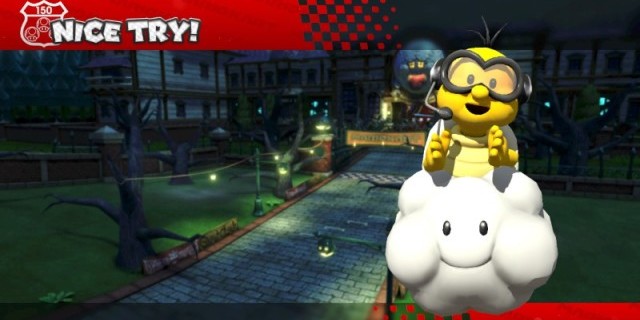
Let’s be honest right up front and admit that the Mario Kart series has settled into the same familiar wheel-spinning evident in a lot of Nintendo’s long-running franchises lately. Of course, there really isn’t that much room for improvement, since the series has been incredible for just about its entire run. Mario Kart 8, like most of its predecessors, adds a couple of interesting new minor features, mixes up the roster (now including five babies and seven Koopalings!), and of course provides 16 incredible all-new tracks along with the now-standard 16 retro courses without noticeably breaking anything important.
The marquee new trick this time around is the ability for the karts to defy gravity along certain sections of the tracks, including modified areas of some of the remakes. While in anti-gravity mode you can earn a speed boost by colliding with other racers or special bumpers placed along the way. This might be the most unintuitive thing in the world after seven titles’ worth of practice avoiding collisions, but you get used to it eventually.
You’re also going to have to get used to some new items, naturally. Boomerang flowers are similar to green shells, except instead of ricocheting around the track, they return to you after a set distance for two more throws. The Super Horn emits a blast radius that will take out anything in range, and in a series first this even includes a dreaded incoming blue shell if you time it right. Then there’s the Crazy Eight, which one-ups the previous Lucky Seven by bestowing a staggering eight items at once: Super Mushroom, Blooper, Green Shell, Red Shell, Starman, Bob-Omb, Banana Peel and a coin.
Yes, coins. Reaching way back into the history of the series like its 3DS predecessor, Mario Kart 8 once again allows you to collect coins to increase your speed, to a maximum of ten. Every time you spin out or are retrieved by Laiktu (who has really stepped up his game in this department), it will cost you three coins; Lakitu takes them from you directly, but otherwise they’ll fall onto the track around you. Coins are also used to obtain additional modifications to your karts, with a new body, tire or glider type randomly unlocked at set intervals.
Mario Kart 8 has also changed the way items are used slightly, which might be a point of contention for series veterans. “Equipping” an item by dragging it behind you no longer removes it from your inventory, so you can’t double up on items any more. Also of note is the fact that the triple items (shells, mushrooms and bananas) automatically equip themselves without your input, which will lead to a few misfires until you get used to not having to hit the button. On the plus side, you will no longer lose your equipped item for falling off the track or being hit, unless a lightning bolt is involved.
Moving to the Wii U has given Mario Kart some interesting new features. Tilt controls come back if you were into that, and you even have the option of using the GamePad’s gyro controls if that’s your thing. The GamePad can also display a map of the track with everyone’s position and current item, or be used for off-screen play. Online play — which allows up to two local players to participate — is becoming more and more painless thanks to not needing to rely on individual friend codes, although I personally would have liked the option to password-protect my room so random friends can’t drop in uninvited if I’m not in the mood.
By far the biggest feature the Wii U’s increased power brings to the table is Mario Kart TV. The Wii U actually retains replays of your last 12 races that you can revisit at any time, and you can select up to six to keep as favorites. Using a limited array of editing options you can focus on up to four specific racers and/or specific events (“big hits,” “drifting,” etc.), and if you find a clip of 60 seconds or less that you like you can even upload it to your YouTube account. The downside here is that the option to view replays has annoyingly somehow become the default selection at the conclusion of a race, although mercifully if you select it by accident you’re only two more hits of the A button away from getting back to business.
With all of this emphasis on new ways to enjoy the races, Battle Mode has continued its sorry decline into vestigial status. Now we don’t even get dedicated arenas! Instead we just get to pop balloons on eight specific normal courses, which can make tracking someone down an incredible chore even if you can travel in either direction at will. Still, being able to have four local players participate in a Grand Prix lessens that blow. A bit. Although giving us back All-Cup Tour would have been nice.
Speaking of nice, this is the first time Mario Kart has been displayed in HD, and it does not disappoint. Even the retro tracks get a chance to shine with the prettier graphics and other updates, making many of them feel almost brand new. The Wii U doesn’t have the raw horsepower of the other systems of this generation, but a neat fact about Mario’s cartoon-like style is that it doesn’t need it in order to keep things running at a silky smooth frame rate at all times (except during split-screen play, but hey).

Mario Kart 8 might not be able to right the troubled ship that has been the Wii U’s performance of late, but it is certainly a strong argument for owning one. See you at the checkered flag!
Pros: The Mario Kart tradition of excellence continues in HD, MKTV sharing via YouTube
Cons: Not a lot of variety in the roster, why even bother with Battle Mode anymore?



















